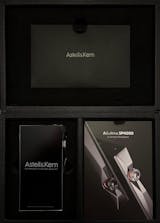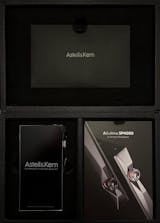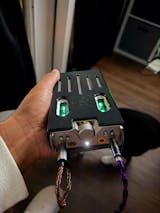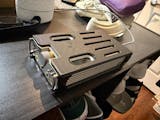

The N6iii features a 4.97-inch display, noticeably larger than the 4.2-inch screen on the
N6ii but well within the one-handed operation limit. To avoid getting bulkier, Cayin eliminated any structural extension around the chassis, giving the front an all-screen appearance. To minimize the width of the DAP, the playback control buttons, and volume knob are tucked beneath the screen. The curved sides improve grip, ensuring that even with a slightly larger screen, the device remains comfortable to hold. As a result, the N6iii delivers a superior visual and control experience, while its size increase is minimal. In today’s era of ever-larger DAPs, the N6iii retains excellent portability.
One of the N6iii’s most significant design breakthroughs is the development of a new
quick-release locking mechanism to swap the audio motherboards swiftly. Fortunately, we have dealt with a similar problem when we develop C9ii and we can modify the “tool-free” quick-release latch into a three-point locking mechanism with a self-locking push-button system, completely doing away with the need for screws. You can watch the video below to see how incredibly easy it is to switch audio motherboards on the N6iii.
The N6iii also has a unique antenna design. In earlier models like the N6ii, the antenna was integrated into the upper back section of the device, with relatively low signal gain to avoid interference. In more recent models (N8ii, N7, N30LE), Cayin adopted an external ring antenna placed on the top of the device, providing high gain and interference-free audio circuitry for a better online streaming experience. For the N6iii, due to strict size limitations, the antenna has been moved to a semi-exposed area, right beneath the top panel of the N6iii DAP. While this placement results in a slightly lower gain than the external antenna design used in N7.N8ii and N30LE, it offers a significant improvement over the previous N6ii without increasing the length of the DAP. It offers excellent streaming performance with minimal interference with analog audio processing.
The C201 Audio Motherboards
Cayin has adopted a new naming convention given the arrival of Gen2 Audio Motherboards. The new naming convention consists of an initial letter followed by three digits:
- The first letter corresponds to the DAC chip manufacturer’s initial, such as C, E, A, etc. (same as the N6ii).
- The second digit is the generation code. For audio motherboards that will be used in N6iii, this will always be 2, representing the second-generation audio motherboard design.
- The third and fourth digits are serial numbers. For example, C201 represents the first application of a second-generation audio motherboard using Cirrus Logic (CS) chips. Currently, the DAC chip is the CS43198. Hypothetically, if we develop another audio motherboard for N6iii with CS43131, it would be named C202.
The Gen2 Audio Motherboard is not backward compatible with the first generation N6ii Audio Motherboards. To accommodate the audio technologies we have mastered in the past 5 years, we need to use a larger PCB in the new generation Audio Motherboard. This is like playing a zero-sum game: when we increase the PCB, we need to make the DAP bigger, and then it becomes less portable. After a lengthy industrial design process, we finalized the N6iii physical design with the following attributes:
- N6iii over dimension (126mm x 77.8mm x 23mm): 26.8% increased from N6ii
- N6iii battery (9000mAH @3.8V): 52.5% increased from N6ii
- N6iii Audio Motherboard PCB: ~30.9% increased from N6ii (based on C201)
First up is the N6iii’s debut audio motherboard, the C201. We can summarize the standout features with a few key terms:
- Parallel Full-Differential Matrix DAC
- High-precision Cascade Volume Control
- Parallel Amplifier




























